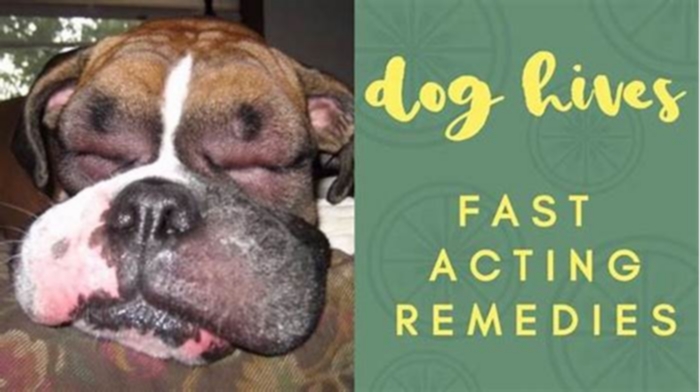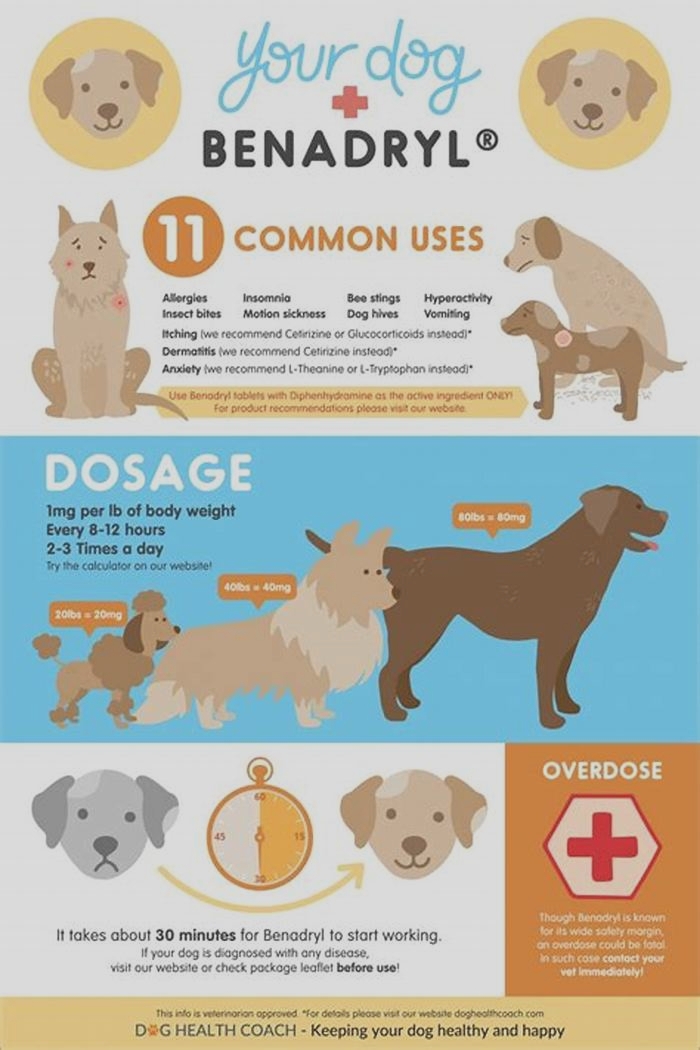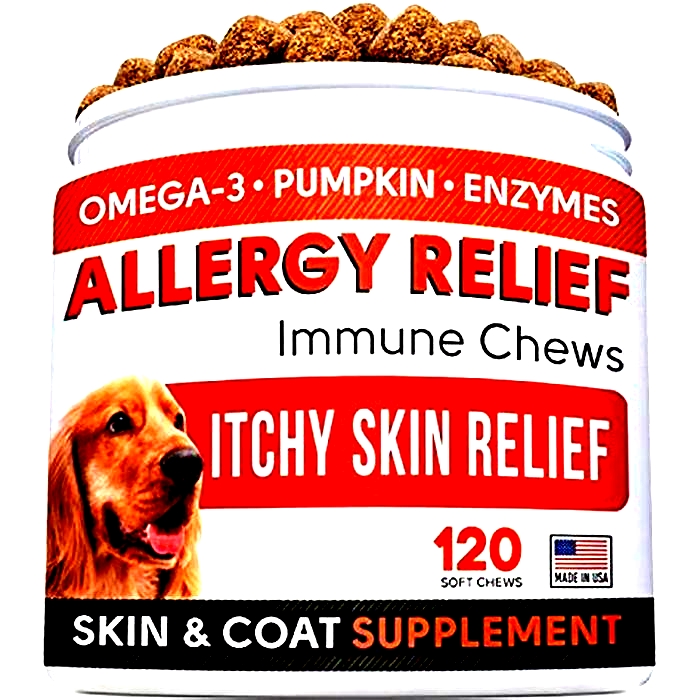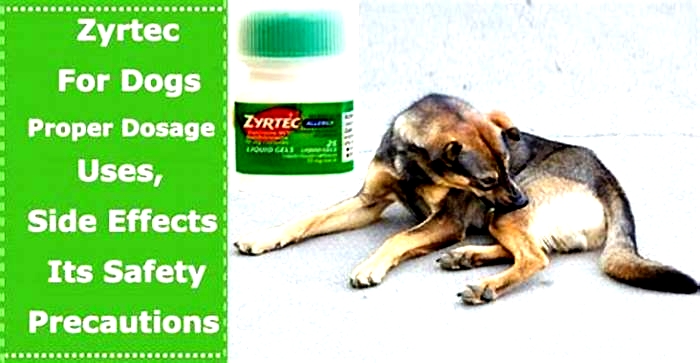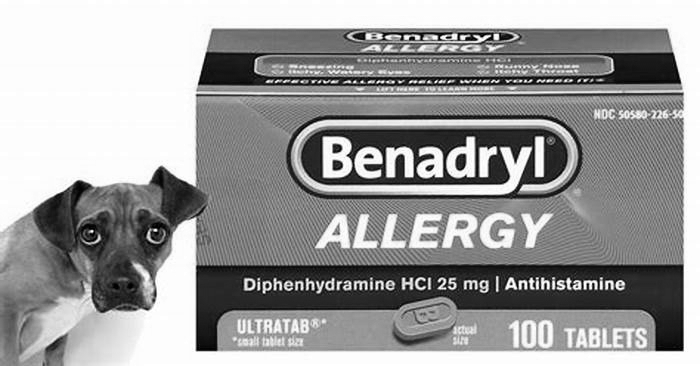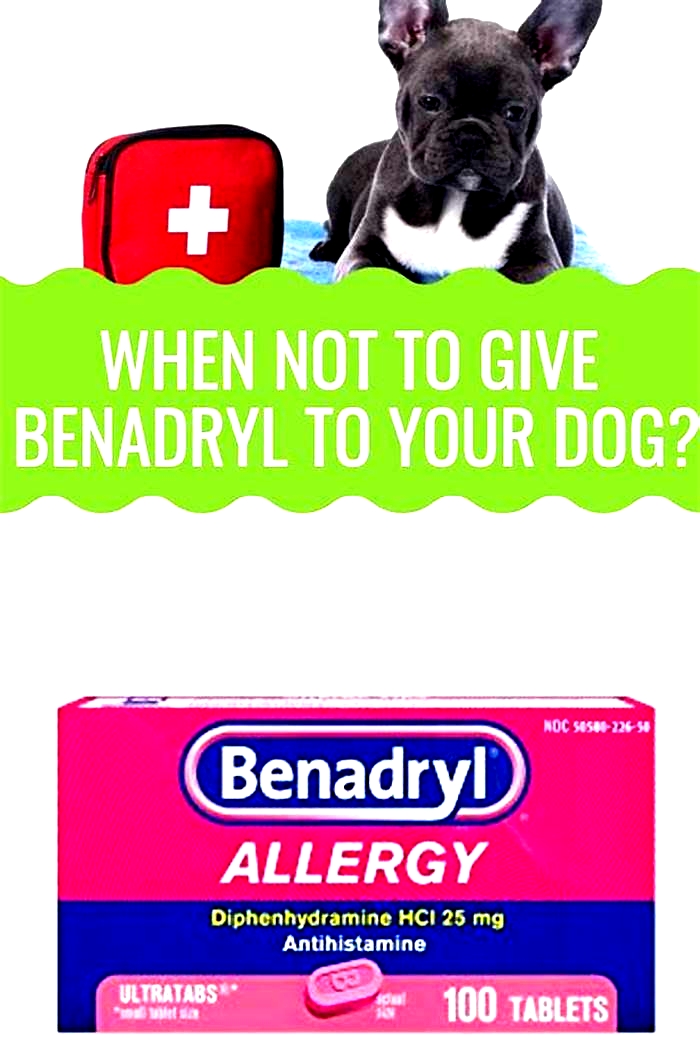Can I give my dog Benadryl for severe itching
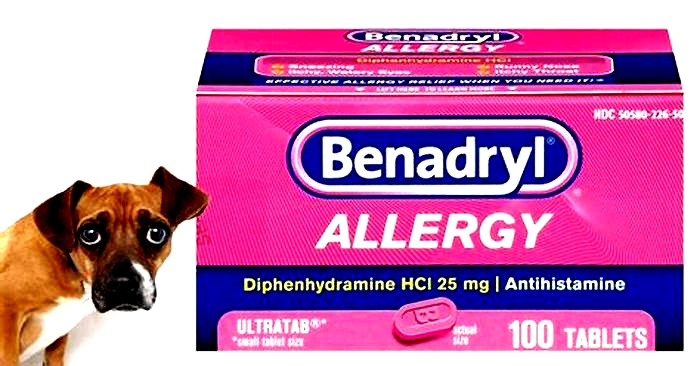
How Much Benadryl Can I Give My Dog? Is it Safe?
Are you wondering whether you can give your dog Benadryl to help with itching, allergies, or anxiety?
Benadryl (Diphenhydramine) is generally safe for most dogs when used correctly. However, before administering this medication to your furry friend, it's crucial to know the recommended dosage based on your dog's weight.
This article will serve as a comprehensive guide for how much Benadryl you can give your dog, how to calculate the proper dosage, and the potential side effects to keep an eye on.
Note: Please remember to consult a veterinarian before administering Benadryl or any other medication to your pet.
Is Benadryl Safe for Dogs?
As a licensed veterinarian, I would say Benadryl is safe for dogs when given at the appropriate dosage. It is an antihistamine that can help alleviate symptoms of allergies, such as itching, swelling, and sneezing.
However, dogs with certain medical conditions may not be good candidates for Benadryl and should only be given the medicine under the guidance of a veterinarian.
Types of Benadryl
Diphenhydraminecomes in various forms, including tablets, capsules, and liquid. Each has its own level of strength in milligrams (mg).
Benadryl is available in:
Tablets- small round tables that come in 25mg or 50mg strength.
Capsules- small capsules that also come in 25mg or 50mg strength.
Liquid- similar to other liquid medications and following a mg/mL dosing, these typically come in a strength of 12.5mg/5ml (2.5mg/ml). If you choose the liquid form, make sure that it does not contain xylitol or other active ingredients.
How Much Benadryl is Recommended for Dogs?
The general guideline for Benadryl dosage is quite straightforward:1 mg of Benadryl per pound of body weight, administered every 8 to 12 hours. This frequency helps maintain the medication's effectiveness throughout the day.
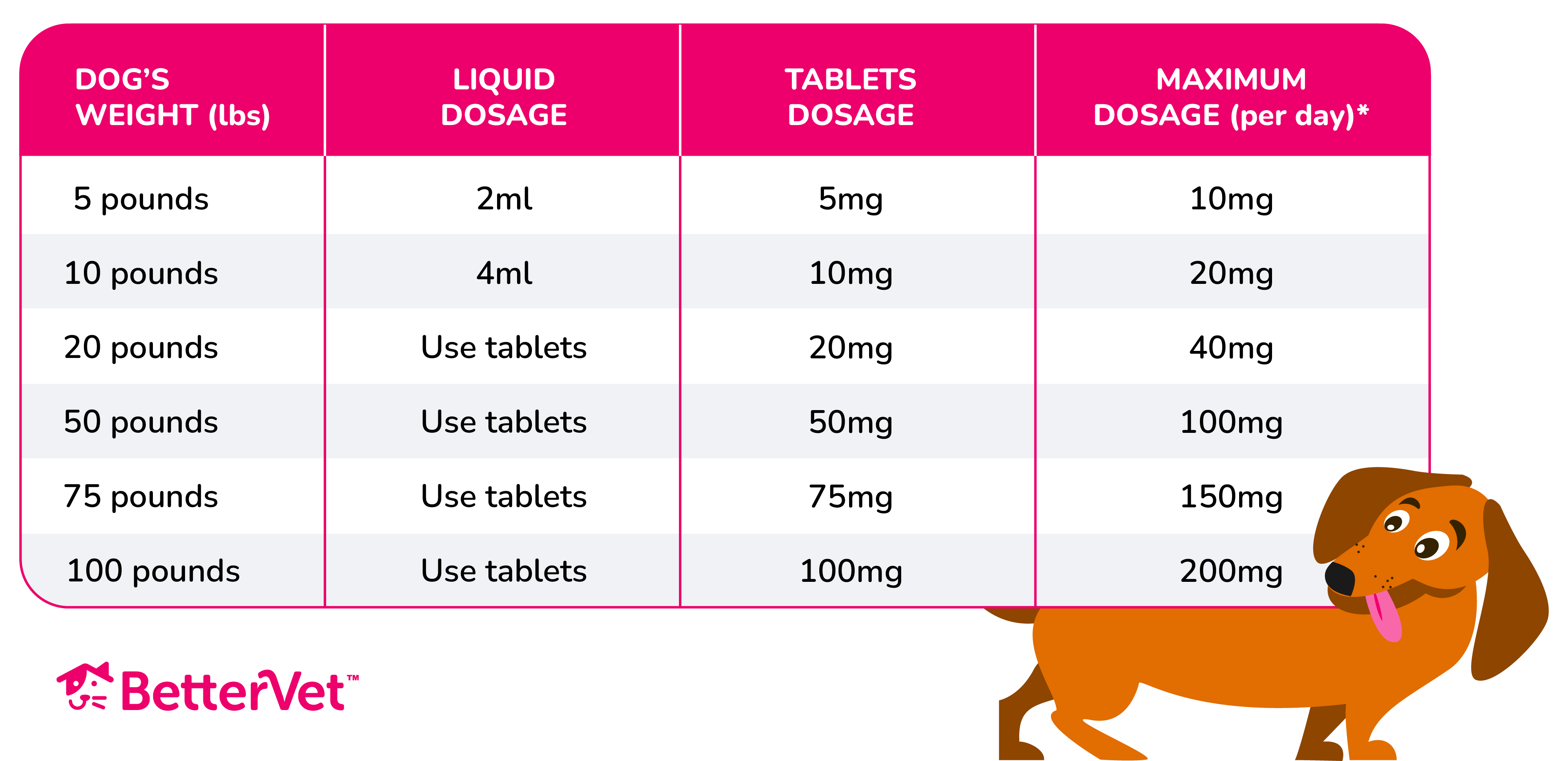
Liquid Benadryl is typically recommended for dogs weighing less than 10 pounds, as this can make it easier to achieve an accurate and appropriate dose.
For dogs weighing more than 10 pounds, most veterinarians recommend tablets, which come in 25-50 mg sizes. Achieving the appropriate dose requires breaking the tablets into quarters as closely as possible. However, it is important to note that the exact dosing will depend on your dog's individual needs and medical history.
Liquid Benadryl Dosage Formula for Dogs
If you need to calculate the appropriate liquid dosage of Benadryl for your dog, you can use a simple formula. First, divide your dog's weight in pounds by 2.5. The result will give you the appropriate dose in milliliters (ml).
For example, if your dog weighs 10 pounds, you would calculate its dosage as follows: 10lbs 2.5 = 4ml.
Once you have determined the appropriate dosage, you can measure it using a syringe or a measuring spoon. It is important to note that one teaspoon is equal to 5 ml, so if your dog requires a dose of more than one teaspoon, you will need to use multiple teaspoons to measure the appropriate amount.
Dog Benadryl Dosage by Weight Chart
Below is a table illustrating how much Benadryl you can give your dog depending on how much it weighs.
Dog Weight (lbs) | Liquid Dosage (mL)* | Tablet Dosage (mg) | Total Daily Dosage (mg) |
5 | 2 mL | 5 mg | 10 mg |
10 | 4 mL | 10 mg | 20 mg |
15 | 6 mL | 15 mg | 30 mg |
20 | 8 mL | 20 mg | 40 mg |
25 | 10 mL | 25 mg | 50 mg |
30 | 12 mL | 30 mg | 60 mg |
35 | 14 mL | 35 mg | 70 mg |
40 | 16 mL | 40 mg | 80 mg |
45 | 18 mL | 45 mg | 90 mg |
50 | 20 mL | 50 mg | 100 mg |
55 | 22 mL | 55 mg | 110 mg |
60 | 24 mL | 60 mg | 120 mg |
65 | 26 mL | 65 mg | 130 mg |
70 | 28 mL | 70 mg | 140 mg |
75 | 30 mL | 75 mg | 150 mg |
*Assuming a liquid concentration of 12.5mg/5mL, which is a common formulation.
Can You Use Benadryl to Treat Allergies in Dogs?
Yes, Benadryl is effective for treating a range of allergy symptoms in dogs. Whether it'sseasonal allergiesor reactions to an environmental irritant, Benadryl can offer quick relief, making it a go-to in my practice for immediate symptom management.
Here are the allergy symptoms Benadryl can help treat in dogs:
Sneezing: Reduces sneezing caused by environmental allergens.
Reverse Sneezing: Can alleviate episodes of reverse sneezing, which are often benign but can be triggered by irritants or allergens.
Red Eyes: Helps soothe red, irritated eyes resulting from allergic reactions.
Watery Eyes: Reduces excessive tear production associated with allergies.
Itching: Eases skin itchiness due to allergies, helping to prevent scratching that can lead to skin infections.
Hives: Reduces the occurrence of hives secondary to an allergic reaction.
Skin Allergies: Offers relief from discomfort caused by allergic dermatitis and other skin allergies.
Seasonal Allergies: Mitigates symptoms associated with seasonal allergies, such as pollen.
If you are unsure if Benadryl is the right medication to treat your dogs allergy-related symptoms,schedule a virtual vet visitwith one of our online veterinarians.
What Else Can You Use Benadryl for in Dogs?
In addition to its use in managing allergy symptoms, Benadryl can have a range of other applications when used in dogs.
Some use cases of Benadryl in dogs may include:
It is also worth noting that while Benadryl can be an effective tool in managing specific health issues in dogs, it may not be appropriate for every situation, and other treatments or interventions may be necessary.
Common Side Effects of Benadryl in Dogs
When administering Benadryl, themost frequently observed side effect is drowsiness. This is due to thesedative properties of diphenhydramine, the active ingredient in Benadryl.
While this can be beneficial in calming allergic reactions, it's important to monitor your pet to ensure they are comfortably resting and not overly sedated.
When giving your dog Benadryl, watch for these side effects:
Drowsiness: The most common effect, due to Benadryl's sedating properties.
Dry Mouth: Increased thirst and frequent water seeking are signs to look out for.
Nausea and Vomiting: Less common, but some dogs may become nauseous.
Increased Heart Rate: A serious side effect that requires immediate veterinary attention.
Rapid Breathing: Another critical sign indicating the medication may not be well-tolerated.
Urinary Retention: Difficulty urinating, a less common but important side effect to monitor.
Can a Dog Overdose on Benadryl?
Yes, a dog can indeed overdose on Benadryl. Overdosing can lead to severe health complications. It's crucial to adhere strictly to the recommended dosage guidelines and consult with your veterinarian to prevent such a situation.
Here are thesigns of a Benadryl overdose in dogsthat you should be aware of:
Rapid Heartbeat: An increase in heart rate beyond the normal range.
Dilated Pupils: Noticeable enlargement of the pupils.
Agitation or Hyperactivity: Uncharacteristic restlessness or increased activity.
Constipation: A noticeable decrease in or absence of bowel movements.
Seizures:Convulsions or severe twitching, which are medical emergencies.
Dry Mouth: Significantly reduced saliva production or extreme thirst.
Urinary Retention: Difficulty urinating or an inability to urinate.
If you observe any of these signs in your dog after administering Benadryl, it's imperative toseek emergency veterinary care immediately.
An overdose requires prompt medical attention to mitigate the risks and ensure your pet's safety and well-being.
Conclusion
In summary, Benadryl (diphenhydramine) can be a helpful and safe medication for treating mild itching, to be used as a mild sedative, and to prevent acute allergic reactions in dogs.
Common side effects of Benadryl in dogs include sleepiness and gastrointestinal symptoms but most dogs will tolerate the medication well.
If you have concerns about giving Benadryl to your dog or if your dog experiences any adverse effects, consult with your veterinarian.
Frequently Asked Questions
How long does Benadryl last in dogs?
Benadryl typically lasts 6-8 hours in dogs. However, the actual duration of effect may vary depending on factors such as your dog's weight, age, and health status.
How long does it take for Benadryl to work on dogs?
Benadryl typically takes effect within 30 minutes to an hour of administration. However, this time may vary depending on your dog's weight, age, and health status.
Can dogs be allergic to Benadryl?
Yes, dogs can be allergic to Benadryl or any other medication. While it is generally well-tolerated, some dogs may experience allergic reactions to Benadryl, such as itching, hives, swelling, or difficulty breathing.
Can I give my dog Benadryl?
Benadryl is commonly used in dogs with mild-to-moderate allergies. It can help relieve symptoms like itching, sneezing, and watery eyes. However, it's important to talk to your vet before giving your dog Benadryl, as it can interact with other medications or health conditions.
The recommended dosage to administer the medication is typically 0.9 to 1.8 milligrams per pound of your dog's body weight, given 1-2 times per day. Always use the appropriate formulation and dosage for your pet's size and weight, and follow your vet's instructions carefully.
Can I give my dog Benadryl for itching?
Yes, you can give your dog Benadryl for itching. Benadryl contains an antihistamine called diphenhydramine, which can help alleviate itching in dogs.
Can I give my dog human Benadryl?
Yes. Benadryl is an over-the-counter medication that is labeled for humans but is generally considered safe for dogs in the appropriate dosage. Always consult with your veterinarian before giving your dog any medication.
Can I give my dog Benadryl every day?
It is generally safe to give your dog Benadryl daily for short periods, as directed by your veterinarian. However, if you plan to give your dog Benadryl for longer than a few days, you should consult your vet to discuss potential risks or concerns.
Can I use Benadryl to sedate my dog for travel?
While Benadryl may have a mild sedative effect on some dogs, veterinarians typically do not recommend it as a primary sedation method for travel. Instead, discussing options for safe and effective sedation with your veterinarian would be best.
How much Benadryl to give a 50 LB dog?
It is generally recommended to provide two 25-milligram tablets, but it's crucial to consult with a veterinarian beforehand to ensure that Benadryl is suitable for your dog's specific requirements and to verify the correct dosage based on your dog's weight and other health considerations.
Read more: 10 Tips for Traveling with Your Pet
Sources and References
Worth, A.C., Wismer, T.A. and Dorman, D.C., 2016. Diphenhydramine exposure in dogs: 621 cases (20082013). Journal of the American Veterinary Medical Association, 249(1), pp.77-82.
Loew, E.R., MacMILLAN, R.O.B.E.R.T. and Kaiser, M.E., 1946. The anti-histamine properties of Benadryl, -dimethylaminoethyl benzhydryl ether hydrochloride. Journal of Pharmacology and Experimental Therapeutics, 86(3), pp.229-238.
Cortinovis, C., Pizzo, F. and Caloni, F., 2015. Poisoning of dogs and cats by drugs intended for human use. The Veterinary Journal, 203(1), pp.52-58.
Why is My Dog Itching So Much? 5 Possible Reasons
Dog itching, or pruritus, is a condition that affects many pups throughout their lives. While most cases are easily treatable, itchiness can also be a sign of more serious issues, including an allergy or infection.
It can be stressful and painful, so for your dogs well-being, its best to take a proactive approach to treatment. That means keeping a close eye on your pup for signs of itching, getting prompt treatment, and taking steps to prevent common causes of itchiness.
If you are wondering if your dog is showing signs of allergic itching, take the quiz below.
In this article, we will review the top 5 causes of dog itching, how to prevent itching, and how to treat itching that is already causing your pup discomfort.
1. Environmental Allergies
Environmental allergies are one of the most common causes of itching in dogs. Just like humans, dogs can suffer from allergies to pollen, dust mites, or mold. This may cause seasonal itching or, depending on the allergen, could affect your dog year-round. Pups may develop a condition called atopy, which is a medical term for irritated skin caused by inhaling allergens like pollen.
Dogs suffering from seasonal allergies might respond to injections designed to expose them to allergens gradually. Allergy desensitization injections could potentially help your dog acclimate to the allergen and reduce symptoms over time.
2. Food Allergies
Dogs may also suffer from food allergies or dietary intolerances. Some dogs are intolerant or allergic to chicken, beef, pork, or other ingredients commonly found in dog food. If your pup is suffering from an allergic food reaction, this may present as a rash, hives, or ear infections.
Hypoallergenic dog food may help to relieve symptoms if you suspect that your dog is suffering from a food allergy. An elimination diet over a period of several weeks in combination with allergy testing, is used by veterinarians to diagnose the root of the allergies.
During a nutritional consultation, your veterinarian will be able to recommend foods for your dog to try to prevent future reactions.
3. Flea Allergies
Flea bites and flea bite allergies are common causes of itchiness in dogs. Fleas typically bite the areas they can access most easily and areas more sheltered from their hosts - your dogs hind legs and rear - so make sure to inspect those areas carefully (although fleas can bite anywhere).
Treatment for fleas is easy and stress-free and can be done with a simple flea shampoo and oral or topical preventatives. It is important to remember that many flea shampoos or rinses will only treat the fleas on your dog at that time and will not prevent further fleas from biting. You will also want to thoroughly clean your dogs toys, blankets, bed, and any other areas of the home where they typically spend time, to ensure that no other fleas or flea eggs are present in your home.
If flea allergies or bites go unnoticed and untreated, they can develop into flea allergy dermatitis, an allergic reaction causing severe pain and/or itching. Its best to have your dog evaluated and treated by a veterinary professional before their condition reaches that level of distress.
4. Contact Dermatitis
Contact dermatitis is a condition that develops from exposure to or direct touching of common household items like cleaning products, bath products, plants (including grasses), and insecticides. If your dog develops contact dermatitis, they will typically itch or develop a rash in the specific area that touched the allergen.
If your dog is suffering from contact dermatitis, they may develop skin infections, including pyoderma, a bacterial infection that results from excessive scratching. If left untreated, complications from itching can cause your dog severe distress and lead to additional skin problems.
5. Insect Bites or Sarcoptic Mange
Aside from flea bites, other insect bites can also cause serious irritation to your pups skin. They may develop sarcoptic mange, a condition caused by mites that leads to inflammation and severe itching.
If your dog is scratching, biting, or licking one area of their body excessively, they may be dealing with irritation from an insect bite. To proactively manage irritation, regularly inspect their body and remove any insects that you find.
If you do notice your dog itching or scratching, their discomfort may be managed with veterinary approved topical treatments like shampoos, ointments, or prescription topical steroids to treat their itching.
Treatment for Itchy Skin on Dogs
Itchy skin can cause extreme discomfort to your pet, so treating it quickly and effectively is essential. While there are home remedies that may help relieve some or all of their pain, I recommend having your dog evaluated by a licensed veterinarian before beginning any treatment.
An experienced veterinarian will be able to offer guidance on home treatment options or prescribe products or medications that will relieve your pups symptoms. Before beginning any course of treatment, a consultation with a vet is strongly recommended.
Once we have identified that your dog is suffering from itchy skin, we will pinpoint the source of their discomfort.
- If they are dealing with flea bites, a flea shampoo in combination with a long lasting preventative may be helpful.
- For an allergic reaction, antihistamines may manage discomfort or allergen desensitization shots may reduce the severity of their reactions.
- Extremely itchy dogs may also benefit from prescriptions such as Apoquel or Cytopoint to quickly relieve symptoms.
Diagnosis may be as simple as scheduling a wellness exam, but sometimes, your dog may require additional testing, including skin scrapings or allergy testing. No matter the cause, we will thoroughly evaluate your pet to determine what is causing their itchiness and develop a plan to resolve their discomfort.
When to Seek Guidance From a Vet
If you suspect your pet is suffering from allergies, seeking professional advice from a qualified veterinarian is the best course of action to relieve symptoms. Dogs may not always show symptoms, so having them evaluated by a qualified professional can rule out potential causes and outline the best treatment plan.
Especially if your dog is experiencing severe symptoms, including excessive scratching, licking, chewing, or recurring ear infections, its important to contact a qualified veterinarian to seek help with reducing their irritation.
Conclusion
Itching can be a painful condition for dogs, even if they arent able to tell you whats wrong. Paying close attention to your pups behavior and conducting regular skin checks is a great way to stay on top of their health and prevent symptoms from occurring altogether. If your pet is already suffering from irritation, having them thoroughly evaluated by one of our expert veterinarians ensures theyll quickly receive the care they need to find comfort.
If youre concerned that your pup is suffering from itchiness or irritation, contact us today for an evaluation.
Frequently Asked Questions
What remedies can I get to stop my dog itching?
Itchy dogs may benefit from various treatments depending on the cause and severity of their itching. I always recommend having an itchy dog evaluated by a veterinarian for the best line of treatment. Dogs may find relief at home from antihistamine creams, flea shampoos, or preventatives to combat insect bites.
Can I give my dog Benadryl for itchy skin?
Benadryl is safe for dogs to take as long as they are given an appropriate dosage. Before giving your dog an oral antihistamine, consult a veterinarian to confirm the correct dosage.
Can I use an anti-itch cream on my dog?
Absolutely. Topical anti-itch creams can be beneficial for relieving symptoms of itchy skin in dogs. Depending on the needs of your pup, an over-the-counter or prescription cream may be recommended. Do not let your dog lick the cream after application and if you are reaching for a steroid cream, consult a veterinarian to ensure its safety.
Why is my dog's itching worse at night?
Dogs may become more itchy at night due to environmental factors like their skin drying out or additional exposure to irritants like dust or cleaning products. If your pup is struggling with nighttime itchiness, let us know, and well be able to recommend the best treatment option to relieve their symptoms.
How do I prevent my dog from developing itchy skin?
Preventative care like regular grooming, topical or oral flea preventatives, worm treatments, maintaining regular hygiene, promoting a healthy diet, and regularly checking for insect bites and skin conditions will help keep your dogs skin healthy. Any issues will be noticed quickly and can then be addressed by a qualified veterinarian to keep your dog itch-free and comfortable.


